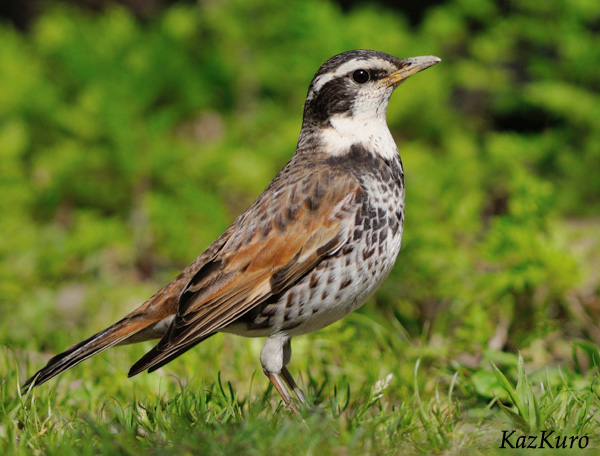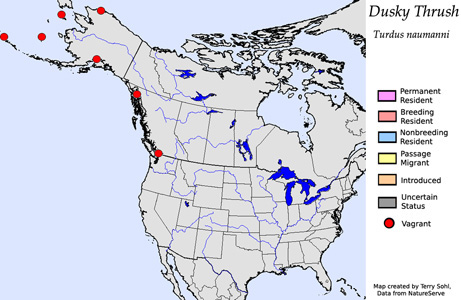| Length: 9.5 inches | Wingspan: 15.25 inches | Seasonality: Non-resident in South Dakota |
| ID Keys: Brown back and wings, dark gray nape and crown, dark face, white supercillium and throat, white unperparts with dark chevon-shaped spots | ||
 The
Dusky Thrush is primarily an Asian bird, breeding in Siberia and wintering
in Southeastern Asia. They are a rare vagrant in North America, with
most records from islands and the coastline of Alaska. Some
classification schemes show two species, Turdus naumanni, "Naumann's
Thrush" and Turdus eunomus, "Dusky Thrush" which is found further
north than Naumann's Thrush. The American Birding Association only
recognizes one species, named Dusky Thrush with scientific name of
Turdus naumanni. In addition to being vagrants in North America,
the species has also on rare occasions been found as far west as Europe.
The
Dusky Thrush is primarily an Asian bird, breeding in Siberia and wintering
in Southeastern Asia. They are a rare vagrant in North America, with
most records from islands and the coastline of Alaska. Some
classification schemes show two species, Turdus naumanni, "Naumann's
Thrush" and Turdus eunomus, "Dusky Thrush" which is found further
north than Naumann's Thrush. The American Birding Association only
recognizes one species, named Dusky Thrush with scientific name of
Turdus naumanni. In addition to being vagrants in North America,
the species has also on rare occasions been found as far west as Europe.
Habitat: Found in open woodlands, with more northerly populations also adapted to living on the edge of the tundra, including in dwarf willow habitat and scrubby riverine thickets.
Diet: Feeds heavily on insects, worms, snails, and other small invertebrates. They will also take berries when available.
Behavior: Foraging is done in the same fashion as many other Turdus thrushes. Dusky Thrush primarily forage on the ground, walking and hopping short distances with periodic pauses as they look for prey.
Nesting: The nest is a cup of grasses, moss, and twigs, bound together with mud and lined with fine grasses and moss. The female lays between 3 and 6 eggs, and she alone incubates them. The eggs hatch after about 2 weeks, and both parents help to feed and raise the young. The young fledge after about 15 days.
Song: Simple whistled song
Migration: Strongly migratory, breeding in Siberia and moving to southeastern Asia for the winter.
Interactive eBird map: Click here to access an interactive eBird map of Dusky Thrush sightings
Feeders: Dusky Thrush will on occasion attend feeders for offered fruits and nut meal.
Similar Species: Distinctive if seen well. Potentially confused with the Eyebrowed Thrush, another rare Asian vagrant, but aside from general structure and the prominent white supercillium on both species, plumage differences should be distinctive on well-seen birds.
Conservation Status: Populations are thought to be stable, the species is found over a very broad geographic area, and they are common in parts of their range. The IUCN lists the Dusky Thrush as a species of "Least Concern".
Further Information: 1) BirdLife International - Dusky Thrush
2) WhatBird - Dusky Thrush
3) NatureWatch - Dusky Thrush
Photo Information: Photo by KazKuro - Photo licensed under Creative Commons Attribution NonCommercial NoDerivs 2.0 Generic License
| Click below for a higher-resolution map |
 |
| South Dakota Status: Non-resident in South Dakota |
Additional Dusky Thrush Photos (coming soon!!)
